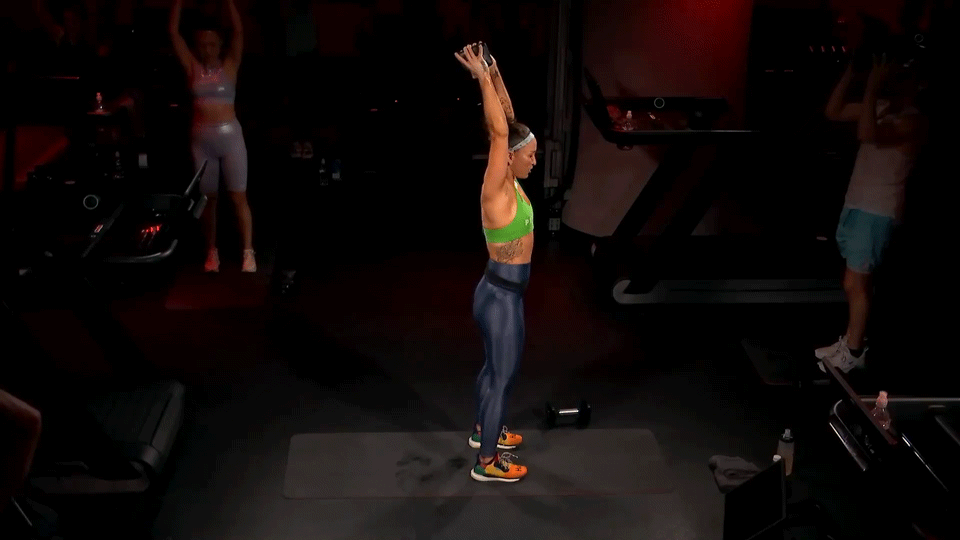This lunge challenge review is part of our Good Sport series. We’re up for any challenge – physical or mental. And this is where we prove it, and then convince you to do the same! Daily burpees anyone?
I’ve done a few different challenges, from Pilates to crunches. But I’ve always wanted to step up my game with lunges. They’re one of those exercises that, no matter how fit you are, it’s easy to mess up on form and half-ass your way through them. And, I find things like this “50 lunges a day” challenge to be a way to stay motivated.
Virtual workouts vs IRL: Which way to exercise is more effective?
How to do a 30-day lunge challenge
How streamlined do you want this challenge to be? You can wake up every morning and do 25 lunges on each leg. Or you can choose full- or lower-body workouts that include lunges. You can even take it a step further and do 50 lunges on each side. That makes for a total of 100 lunges, instead of the 50, if you like. You can also set a calendar reminder each day. I started on August 1 and did it every day that month. So, I guess you could say I did a 31-day challenge.
You can also use FLEETSTREET’s handy log and post it on your stories or idea pins. Just add a giphy or emoji before hitting post.

What are lunges?
Lunges are a compound exercise, involving multiple muscle groups and multiple joints. It’s also a functional exercise, meaning you’re training for movement we naturally do every day). They work the hip flexors and knees, as well as the glutes, quads and hamstrings. It’s an impressively effective exercise that can make you more toned and stronger. And it can make you a better athlete too. Whether your sport is running, hockey, soccer or just flexing (how damn good your legs look), there are benefits.
Lunges are not just an exercise but also “a great warm up exercise for activating your legs or used for a focused leg workout,” according to Migz Pink, an active lifestyle coach, founder of meversusme.ca and City Shred trainer. Not to tire you before a workout, but he’s right. It’s a functional compound movement that can warm up your leg muscles as well as the rest of the body.
The proper form for a lunge
Here is how to do a proper lunge:
- Stand with your feet parallel and positioned directly under your hips. Put your hands on your hips and stand with a tall posture and a neutral spine. “The best form for lunges is to stand up straight [and] tall, shoulders relaxed, chin up,” says Pink. “You can have your arms at your side or your hands on your hips.”
- Either step forward or backward – either way your back foot will sit on the toes with the heel up. Keep your hips and feet facing forward, ensuring that your knees do not bow outward.
- Lower your body straight down, not leaning forward, until your both knees are bent at 90 degrees. “Make sure your front knee is directly on top of your ankle, and that the back knee is inches off the floor,” says Pink.
- Pause briefly, and bring your body back up and return your feet together.
Hands down, the easiest fix – how I stopped wrist pain during exercise.
Who shouldn’t do lunges
Pink warns against doing this exercise if you have bad knees and/or are not able to bend your knees to 90 degrees. However, there is research showing that lunges can be an effective form of rehabilitation – under the right care, of course.
Should your knee touch the floor with lunges?
Yes. And, not necessarily.
I started including the lunges in my workouts as part of my lunge challenge – mostly for variety and to keep my eye on form. And I noticed that some instructors asked for the knee to touch the ground and others didn’t. Back knee on the ground is the full range of motion (ROM), and it really activates your muscles and joints. I asked Peloton to help clarify when you don’t need to touch the floor.
“There are two main reasons why an instructor would call for limited range of motion,” says Peloton Instructor Andy Speer. “One, if they are offering a modification for the exercise, limiting ROM may be more appropriate for some members due to injuries, mobility limitations or that they are simply developing the strength needed for the full ROM. Keep in mind, you will still get strength training benefits of the lunge even if your knee doesn’t touch the floor. Work safely from where you can to progress your strength and eventually work up to full ROM.
“Two, partial ROM reps are a great way to keep tension on your muscles throughout the set, so an instructor may call for limited ROM to actually increase the stress on your muscles – quads, glutes, hamstrings – even while lessening the ROM.”
Workout motivation tips from elite trainer Eva Redpath.
Common mistakes with lunges
The biggest mistake people make when doing lunges is just rushing the move and not going through the proper steps. Rushing could get your heart rate up, but it causes bad form as you’re compromising quality for speed. And that can lead to injury.
In the beginning of my challenge, I just wanted to get the 50 lunges done and done quickly. But I noticed that I leaned into the lunges, which I instantly knew wasn’t right because it felt wrong.
“By leaning too far forward with your lunges it can cause added strain on your joints and knee,” says Pink. And Speer agrees: “Leaning too far forward in the forward lunge [means] letting your torso put too much weight on your front knee and foot. Your knee can push over your toe. That’s OK, but your front foot must feel the weight evenly distributed from heel to toes. If you feel more weight on the ball of your foot at the bottom of the lunge, shift your torso and hips back towards your rear foot slightly.”
The opposite problem of that is “arching or flexing your back,” says Speer. To fix it, keep your posture tall and long. “Pull your ribs in, which engages your abs. Don’t hunch forward or arch backwards. A slight lean or hinge at your hips is OK, [as] your torso doesn’t have to be perfectly vertical, but you should maintain good posture.”
Also watch your knees, says Speer. You don’t want your “knees falling in or out. Keep your knee straight in line over your middle toes. Generally an awareness [of] this and a conscious effort to fix it goes a long way.”
Another mistake, according to Pink, is taking too big of a step. That ends up as more of a stretch than a strengthening exercise. “To ensure form isn’t compromised, be tall, [have your] chest out, and your knee and ankle should be aligned while the weight should be driving through your heels,” says Pink.
Check yourself in a mirror or self mode on your fitness app. And if something doesn’t feel right or the wrong muscles are engaged, stop, shake it off and try again.
Does the lunge challenge work?
I did notice a huge difference in my form. At the beginning of my lunge challenge, I had to remind myself to position my shoulders over my hips and not lean. By the end, I was more focused on the working muscles than balance, which is great. (That’s be because doing lunges daily has been shown to improve balance, actually.)
But the game changer for me was touching my knee to the floor on the back leg. I had to use my entire body to go through the motion of dropping the knee and getting myself back up – especially for 50 lunges! At night, I felt pure exhaustion in my leg muscles and actually slept better. I also noticed my legs had a subtly better shape, tightening around the knee and hip and a nice sweep between. The glutes and abs got into the activation, too. I used my arms, not for momentum, but to create athletic movement throughout the lunging movement. Felt good!
How to advance lunges
Like all exercises, yes, of course, you can advance lunges. “If lunges feel easy and you don’t feel muscular fatigue or a burn, it’s time to step it up,” exclaims Pink.
Pink says to add props with a weighted dumbbell lunge or overhead barbell lunge, reduce breaks by doing walking lunges, go off balance with rear foot-elevated lunges (putting the laces of your shoe on the back foot down on a bench, step or chair).
Use a raised surface like a chair or bench. Place one foot on the raised surface to start. “Drive through the raised leg, step up and bring the opposite foot to meet the raised foot/leg. If you feel your balance, stability, mobility or strength is compromising your ability to complete the exercise, you may need to modify it.”

How to modify lunges
Whether you’re a beginner, feeling tired af or have an injury but want to keep exercising, modifying an exercise isn’t just OK to do, it’s recommended. Here’s how.
To help with balance, try a reverse lunge, “where you start straight and tall, step backwards,” says Pink. Your legs are both bent at 90 degrees, just like with a regular lunge. “Then step [forward] and bring both feet together [to] stand straight and tall.”
Also don’t get hung up on having to modify as you will likely be able to progress. “As with any exercise, there are many modifications or variations that are effective and safe,” says Speer. “Do whatever variation is best for you.”
A love letter to my booty band – it’s true love, not a booty call.
Do lunges cause body imbalances?
When I met with my osteopath, she asked me if I did lunges the day before because my hips weren’t level. Weird, because I was doing them daily?
“As humans, we are inherently imbalanced in both our upper and lower body limbs due to our dominant sides taking work more naturally,” says Speer, giving the examples of picking up shopping bags, babies, etc. with our dominant hands. “It’s the same when it comes to athletics.”
But a minor imbalance is not something to worry or stress about, says Speer. However, “if you want to work to balance it out, you can use some tricks like adding one to three reps to your non-dominant leg per set, or doing one to two extra sets of lunges during or after your workout.”
If you’re like me, and are doing your lunges during workout strengthening class, “pace your dominant leg, then add one to two reps for your non-dominant leg.” He points to using Peloton Guide’s rep tracking and class collections, like Pump Up The Volume, to progress through exercises. “Over time, adding reps and volume will help to balance out the difference.”
If you have an imbalance that you’re concerned about affecting your mobility and lifestyle, definitely mention it to your doctor, physiotherapist or personal trainer.
What is Peloton Guide? Should you add to cart?
Why is the “50 lunges a day for 30 days” challenge so damn good?
While in a class you might be trying to beat another person in reps or timing, this 50 lunges a day for 30 days challenge allows you to contend with yourself and see your own gains.
“You have the ability to complete anything you put your mind to,” says Pink. “Don’t compare yourself to anyone else, your only competition is you. [That’s the] Me Versus Me mentality – lock in and get it done!”
Working out with an injury blows – but these expert tips make it suck less.
What did I learn from my lunge challenge?
I learned that my recent shoulder injury really did set me back. Not just on my shoulder, but my overall fitness, which really did suck. But not for long. I would say that it only took one week of sloppy lunges before I finally felt some grace in the movement.
I also learned that, to make the most impact, I couldn’t just go through the motions of a lunge, but really use the movement as I would in everyday life.
So, no, I wouldn’t just stand there and bounce with a bend that had my knee barely touch the floor. But I would need to be able to get up off the floor from a kneeling position – whether it’s saying hello to my cat or grabbing something from underneath the bed. It’s more effective for me to bring my knee all the way down, because, well, that’s how I would really move.
That’s when I felt DOMs (delayed onset muscle soreness) and when I noticed an improvement in my form because, well, my legs were getting damn stronger. And not touching the floor with my back knee felt like cheating. It’s funny how progress makes you not just stronger, but also better. Thank you lunges!

